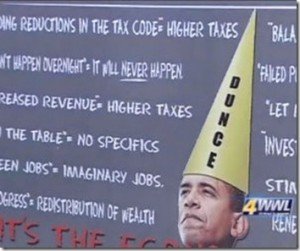Obama’s Education ‘Progress’ Is Only Union Hiring Not Improving Education
The President conflates the quantity of teachers with their quality. At best, these two factors are uncorrelated. At worst—in those few states and districts which pay teachers based on performance—the two factors are negatively correlated …
by Andrew J. Coulson at Cato @ Liberty
The President and Governor Romney have dueling op-eds in Time Magazine that are nominally about higher education. Neither really is. Governor Romney’s piece, in fact, doesn’t seem to be about anything at all, its vagueness evoking Isaac Asimov’s Lord Dorwin. The President’s piece does offer a few concretes, but mostly about K-12 and entirely wrongheaded. On the principle that bad specifics are worse than no specifics at all, let’s start with President Obama. He writes:
We know that a good teacher can increase the lifetime income of a classroom by more than $250,000. A great teacher can change the trajectory of a child’s life. That’s why, even as we faced one of the worst economic crises in history, I fought to keep teachers in the classroom.
The President conflates the quantity of teachers with their quality. At best, these two factors are uncorrelated. At worst—in those few states and districts which pay teachers based on performance—the two factors are negatively correlated: employing more teachers leaves less money to pay suitable salaries to excellent ones.
We have already doubled the public school workforce over the past 40 years despite having only 8.5% more students today than we did in 1970. Put another way, employment has grown 11 times faster than enrollment. What good did it do? See the charts here. After hiring 3 million additional public school employees—two million of them teachers or teachers’ aides—student performance at the end of high school is essentially flat. The cost of this public school employment bloat is about $210 billion annually—roughly double the combined state budget shortfalls for 2012.
The President knows all this, but can safely assume that most American voters don’t. Thanks to decades of misreporting by the media, most Americans think public school class sizes have been growing and spending has been declining, when in fact the complete opposite is true.
[From ‘Public School Spending: There’s a Chart for That‘ “In the past, some readers have wondered if the use of two separate scales ($ on the left and % on the right) might skew the way we perceive these numbers, making the public school productivity collapse look worse than it really is. To allay that concern, I present an alternate version of the chart that places all the data on the same percentage scale. Alas, the second picture is no less bleak than the first.
If music players had suffered the same cost/performance trends we’d all still be lugging around cassette boom boxes, but they’d now cost almost $1,800…. Aren’t you glad we didn’t give tax-funded state monopolies to 19th century Victrola manufacturers?”]
Next, President Obama claims to have spurred states “to raise standards for teaching and learning.” Even if we grant the President’s unjustified assumption that high government standards improve student performance, he is ignoring the reality that his administration’s policy of conditionally waiving requirements of the federal NCLB law have caused some states to lower their standards. A recent and notorious case is Florida, which, thanks to an Obama administration NCLB waiver, has introduced new standards for educational achievement by race and ethnicity: black students will be held to a lower standard than Hispanics, who will be held to a lower standard than whites, who will be held to a lower standard than Asians. Had this happened under a previous administration, the national media would have assailed it as institutional racism and pilloried the President for pursuing the policy that precipitated it.
In a sensible world, each and every child would be helped and encouraged to fulfill his or her individual potential. Children are not interchangeable widgets to be sorted by color—or, for that matter, by age. Proclivity to learn differs not only between kids, but even within them, from one subject to the next.
We live at a time when it is easy to tailor instruction to each child, individually; grouping them—when group instruction is advantageous—based on where they are in the material in each subject, not purely on their age or some other arbitrary measure. The Jesuits started doing this in 1599, for heaven’s sake, we should certainly be doing it in 2012.
Indeed, the private tutoring sector already functions this way all over the world, because it seeks to provide the most educational value for parents’ dollars. Such individually-tailored instruction is unlikely to ever dominate the government-run approach to schooling championed by President Obama.
Andrew J. Coulson is the director of Cato’s Center for Educational Freedom. Previously, he was senior fellow in Education Policy at the Mackinac Center for Public Policy. He serves on the Advisory Council of the E.G. West Centre for Market Solutions in Education at the University of Newcastle, UK, and has contributed to books published by the Fraser Institute and the Hoover Institution. He is author of Market Education: The Unknown History, the only book to address contemporary education policy questions by drawing on case studies from across the entire span of recorded human history. Full bio>
Help Make A Difference By Sharing These Articles On Facebook, Twitter And Elsewhere:



